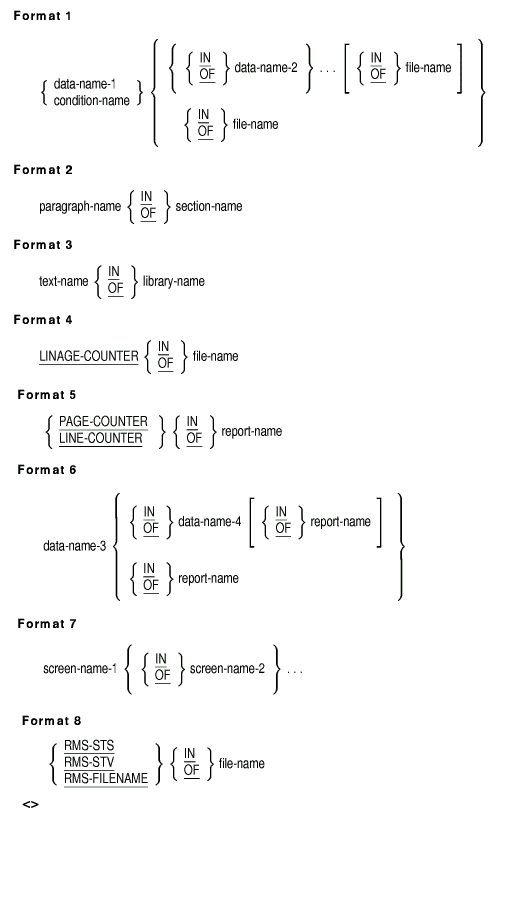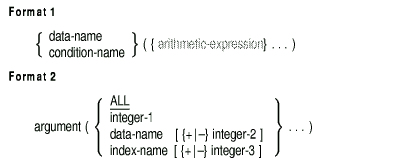 |
HP COBOL
Reference Manual
When a program is contained within a program or contains another
program, specific conventions apply. (See Section 6.2.6.)
The general formats for qualification are as follows:

The following syntax rules apply to qualification:
- Each reference to a nonunique, user-defined name must use a
sequence of qualifiers that eliminates ambiguity from the reference.
- A name can be qualified even if it does not need qualification. If
more than one set of qualifiers ensures uniqueness, any set can be used.
- IN and OF are equivalent.
- In Format 1, each qualifier must be either the name associated with
a level indicator, the name of a group to which the item being
qualified is subordinate, or the name of a condition variable with
which the condition-name being qualified is associated. (See
Section 6.2.5.) Qualifiers must be ordered from least- to
most-inclusive levels in the hierarchy.
- In Format 7, each qualifier must be the name of a group to which
the item being qualified is subordinate. Qualifiers must be ordered
from least- to most-inclusive levels in the hierarchy.
- In Format 1, data-name-2 can be a record-name.
- If the program contains explicit references to a
paragraph-name, the paragraph-name cannot appear more
than once in the same section. When a section-name qualifies a
paragraph-name, the word SECTION cannot appear. A
paragraph-name need not be qualified in a reference from
within the same section. You cannot reference a paragraph-name
or section-name from any other program.
- On OpenVMS, in Format 3, a COPY statement that accesses an OpenVMS
Librarian library-record must qualify text-name with
library-name. <>
- In Format 3, on Tru64 UNIX systems, the library-name
for the COPY statement will direct COPY to access the
text-name file from the library-name subdirectory.
<>
See Chapter 8 for information on the COPY statement.
- If the program has more than one file description entry with a
LINAGE clause, every reference to LINAGE-COUNTER must be qualified.
- If the program has more than one report description entry, every
Procedure Division reference to LINE-COUNTER must be qualified.
- In the Report Section, an unqualified reference to LINE-COUNTER is
qualified implicitly by the name of the report in whose report
description entry the reference is made. Whenever the LINE-COUNTER of a
different report is referenced, LINE-COUNTER must be qualified
explicitly by the report name associated with the different report.
- If the program has more than one report description entry, every
Procedure Division reference to PAGE-COUNTER must be qualified.
- In the Report Section, an unqualified reference to PAGE-COUNTER is
qualified implicitly by the name of the report in whose report
description entry the reference is made. Whenever the PAGE-COUNTER of a
different report is referenced, PAGE-COUNTER must be qualified
explicitly by the report name associated with the different report.
- On OpenVMS, if the program has more than one file description
entry, every reference to RMS-STS, RMS-STV, and RMS-FILENAME must be
qualified. <>
6.2.2 Subscripts and Indexes
Occurrences of a table are not individually named. You refer to them by
using a subscript or index to specify their location relative to the
table's beginning. Subscripting is a general operation; indexing is a
special form of subscripting.
Unless otherwise specified by the rules for a statement, subscripts and
indexes are evaluated once, at the beginning of a statement. If a
statement contains rules describing the evaluation of subscripts, those
rules also apply to the evaluation of indexes.
Subscripting
Subscripts can appear only in references to individual elements in a
list, or
table, of like elements that do not have individual data-names. (See
the Section 5.3.35 clause in Chapter 5.)
The general format for subscripting is as follows:

All restrictions in the rules for subscripting also apply to indexing
(See the following subsection describing Indexing.) The following
rules apply to subscripting:
- A subscript can be represented by any arithmetic expression.
- In Format 2, argument is an intrinsic function argument
that is allowed to be repeated a variable number of times. Note that
Format 1 also applies to intrinsic function arguments, but not with ALL
subscripts. When ALL is specified as a subscript, the effect is as if
each table element associated with that subscript position were
specified. (For a list of the intrinsic functions that permit arguments
with ALL subscripts, and for more information, see Chapter 7.) Also
in Format 2, data-name is the data-name of a numeric integer
elementary item.
- Identifiers in subscript arithmetic expressions must refer to
elementary numeric data items.
- The lowest valid subscript value is 1. This value points to the
first element of the table. Subscript values 2, 3, and so on, point to
the next consecutive table elements.
- The highest valid subscript value is the maximum number of
occurrences of the item specified in the OCCURS clause.
- The subscript or set of subscripts that identifies the table
element is delimited by a balanced pair of left and right parentheses.
- Each table element reference must include subscripting. However,
the reference cannot include subscripting when it is one of the
following:
- The subject of a SEARCH statement
- In a REDEFINES clause
- In the KEY IS phrase of an OCCURS clause
- The subscript or set of subscripts follows the table element's
data-name. The data-name is then called a subscripted
data-name or an identifier.
- The number of subscripts following a table element reference must
equal the number of dimensions in the table; that is, there must be a
subscript for each OCCURS clause in the hierarchy that contains the
table element and one for the table element itself.
- A data-name can have up to 48 subscripts.
- Subscripts must appear in the order of successively less inclusive
dimensions of the table.
- An arithmetic expression in a subscript cannot begin with a left
parenthesis if the preceding arithmetic expression ends with a
data-name.
Note
Use the
check
compiler option with the
bounds
keyword for run-time upper- and lower-bound subscript range
verification. The default action is not to check. For more information,
refer to the COBOL online help file for your particular platform.
|
In the following examples, references to ITEME require two subscripts.
The first subscript refers to the occurrence number of the most
inclusive dimension, ITEMD (that contains ITEME).
| Example 6-1 Subscripting Example |
WORKING-STORAGE SECTION.
01 ITEMA PIC 99 COMP VALUE IS 3.
01 ITEMB PIC 99 COMP VALUE IS 5.
01 ITEMC VALUE IS "ABCDEFGHIJKLMNOPQRSTUVWX".
03 ITEMD OCCURS 4 TIMES.
05 ITEME OCCURS 6 TIMES PIC X.
|
|
IDENTIFIER
|
VALUE
|
|
ITEME (4,3)
|
U
|
|
ITEME (ITEMA,ITEMB)
|
Q
|
|
ITEME (ITEMA * 2 - 4, ITEMB - 2)
|
I
|
|
ITEME (ITEMA * ITEMB / 15, (ITEMA + ITEMB) / 4)
|
B
|
Indexing
Indexing is a special subscripting procedure. In indexing, you use the
INDEXED BY phrase of the OCCURS clause to assign an index-name
to each
table level. You then refer to a table element using the
index-name as a subscript.
The general format for indexing follows:

All the restrictions in the rules for subscripting apply to indexing.
(See Subscripting.) The following rules apply only to indexing:
- You must give index-name an initial value before using it.
You can do this in:
- A SET statement
- A SEARCH statement with the ALL phrase
- A PERFORM statement with the VARYING phrase
Furthermore, only the statements in the previous list can change
the value of index-name.
- Indexing can be either direct or relative. Direct indexing means
that the value of index-name or literal-1 is the
occurrence number. Relative indexing means that the occurrence number
is the value of index-name plus or minus literal-2.
literal-2 must be an unsigned integer.
Note
Use the
check
compiler option with the
bounds
keyword for run-time upper- and lower-bound index range verification.
The default is not to check. For more information, refer to the COBOL
online help file for your particular platform.
|
Example 6-2 is similar to Example 6-1 that illustrates
subscripting. However, this example shows the use of index-names in
references to the table, initializing indexes with the SET statement,
and storing index-name values in index data items.
| Example 6-2 Indexing Example |
WORKING-STORAGE SECTION.
01 ITEMA USAGE IS INDEX.
01 ITEMB USAGE IS INDEX.
01 ITEMC VALUE IS "ABCDEFGHIJKLMNOPQRSTUVWX".
03 ITEMD OCCURS 4 TIMES
INDEXED BY DX.
05 ITEME OCCURS 6 TIMES
INDEXED BY EX PIC X.
PROCEDURE DIVISION.
PARA.
SET DX TO 4.
SET EX TO 1.
DISPLAY ITEMD (DX). (1)
DISPLAY ITEME (DX, EX). (2)
DISPLAY ITEME (DX - 3, EX) (3)
SET ITEMA TO DX.
SET ITEMB TO EX.
|
|


